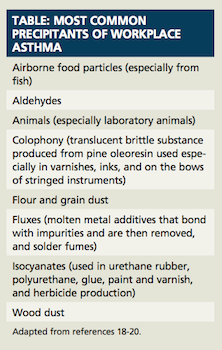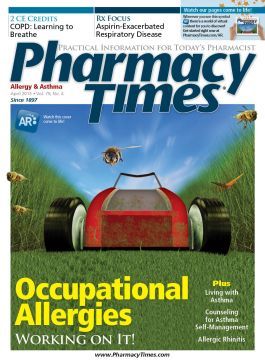Publication
Article
Pharmacy Times
Occupational Allergies: Working On It!
Author(s):
Pharmacists are often the first clinicians to see cases of occupational dermatitis, rhinitis, and asthma.
Pharmacists are often the first clinicians to see cases of occupational dermatitis, rhinitis, and asthma.
It’s bad enough that we all have to work, but when work makes you sick, it's a compounded tragedy! Workplace allergies are common and significant sources of illness, with contact dermatitis and occupational asthma being the most prevalent of these afflictions (see online Table1-12 below).
Skin Allergies
Occupational dermatitis, especially irritant contact dermatitis and allergic contact dermatitis, is the most common cause of occupational disease and accounts for the most workdays lost among all occupaional allergies.13,14 Pharmacists are most familiar with the allergies we used to see often in our own workplace—before we realized that latex was the culprit. Latex is found in gloves, catheters, drip sets, and injectable medications’ stoppers. Although pharmacists may be familiar with latex allergy, it deserves special note.
Latex is the most common allergen associated with dermatitis. Its incidence accelerated in the 1980s when latex gloves gained popularity and manufacturers substituted starch for talcum powder to prevent granuloma formation; starch diffuses allergens extremely efficiently.
Latex allergy may present as rash, asthma, rhinitis, or even anaphylaxis and possible death. Latex-sensitive individuals should wear medic alert bracelets and carry injectable epinephrine and antihistamines. Latex is present in many types of supplies used to provide health care, although manufacturers have eliminated latex in most products.
It is also present in many consumer items, and people with this allergy need to be very careful when they buy toys, home furnishings, and recreational equipment.14,15 Up to 58% of latex-allergic patients experience cross-reactivity with avocado, banana, chestnuts, and kiwi fruit. Patients may develop allergies to other fruits (eg, fig, papaya, tomato).16,17 Latex allergy is best treated with steroids and antihistamines on the first occurrence and avoidance of latex products after that.14
Online Table: Common Workplace Allergens
Occupation
Potential Allergen and Manifestation
Bakery and Food Service Workers
· Wheat flour exposure can cause nasal symptoms (eg, rhinitis, nasal allergies, etc.) or a systemic reaction
· Soy beans, fish, shellfish, and egg can cause systemic reaction
· Peanut-based products can cause systemic allergic reaction
Carpenters and Wood Workers
· Exotic hardwoods can cause rhinitis, asthma, or contact dermatitis
Chemical and Pharmaceutical Factory Workers
· Enzymes, medication, and biological dusts can cause sensitivity allergy
· Ammonia, bleach, and chloramines can cause rhinitis
Cleaning Staff
· Bleaches and enzymes from detergents can cause contact dermatitis or asthma
Electrical Workers
· Fumes from soldering may cause lung disease
Engine Mechanics
· Benzene can cause contact dermatitis
Farm Workers, Dockworkers, and Cotton Workers
· Moldy hay stored in silos can cause hypersensitivity pnuemonitis (now rare)
· Poultry and plant dusts can cause asthma
Florists
· Primula, ivy, and lilies can cause contact dermatitis
Hairdressers
· Paraphenylenediamine in dyes and bleaches can cause contact dermatitis and eczema
· Persulfates in permanent wave solution can cause respiratory distress or dermatitis or eczema
Laboratory Workers
· Animal dander, saliva components, or bird proteins can cause asthma
· Endotoxins can cause asthma
· Solvent vapors and inorganic acid vapors or mist may cause rhinitis
Laborers
· Chromium in cement can cause contact dermatitis
Medical Workers
· Latex rubber in gloves, tubing, and medical supplies can cause contact dermatitis
Miners
· Coal dust can cause nasal symptoms or chronic lung disease
· Silica can cause pulmonary complications
Pharmacists
· Psyllium dust may cause rhinitis
· Antibiotic exposure may cause sensitization allergy or contact dermatitis
Printers
· Acrylic dyes can cause contact dermatitis and rash
Occupational Rhinitis or Nasal Allergies
Sneezing, nasal discharge, congestion, and obstruction (collectively called rhinitis) during the workday may indicate occupational disease. Workers exposed to drugs, wood dust, chemicals, metals, and biocides are at high risk. Occupational rhinitis may precede occupational asthma, so early diagnosis may prevent future complications.4,6 At-risk individuals may also develop sinusitis, olfactory dysfunction, and vocal cord problems. Management after removing the allergen may include saline nasal lavage, topical steroids, and antihistamines.6
Occupational Asthma

Workers who are repeatedly exposed to, inhale, and become sensitized to certain airborne agents can develop occupational asthma. Workplace exposure accounts for 5% to 15% of all asthma cases in industrialized nations.1 More than 250 agents have been reported to cause occupational asthma.18-20 Often at-risk workers develop rhinitis with a slowly progressive cough, wheezing, and shortness of breath. Workplace asthma may progress within days to weeks of exposure to allergens, or after years of repeated exposure to causative agents. Workers who have preexisting mild asthma and smokers are at increased risk. An undetermined number of cases are undetected and experts think this is a very large number.2 Once sensitized, workers may experience reactions even after exposure to minute quantities of allergen. Experts believe occupational asthma is underdiagnosed.21 One clue that can help diagnosis: a patient reports that symptoms improve on weekends or vacations.
Ideally, all asthma patients should be treated following current guidelines. If occupational asthma becomes a chronic disease, patients will need the usual pharmacologic management.
Suspecting Occupational Allergy
Occupational health inspectors are aware of industries associated with known occupational allergens and should routinely monitor preventive measures and assess air samples. These workplaces often have on-site occupational health physicians to implement preventive programs and identify new cases early. Preventive measures include lung testing, skin testing, and employee education. Employers usually provide environmental control measures such as adequate ventilation, painting booths, extractor fans, protective clothing, masks, respirators, and visors. Employees, however, may cut corners in the interest of time or convenience. For example, a welder may forgo safety equipment if he is “just doing a small job,” or a lab worker may think that gowning up and putting on protective equipment is a waste of time.
Pharmacists, with their good interview skills and accessibility, may be the first clinicians to see cases of occupational allergy. Pharmacists can take a front-line role by learning about industries in their area and the associated common allergens. Asking about a patient’s occupation when gathering baseline data is not only an icebreaker—it helps identify patients at risk. Once patients explain their occupation, take the questioning a step further and ask:
- The patient to explain their job
- Specifically about chemicals, paint, dust, or fumes
- If symptoms worsen at work or in the early evening or improve over weekends or absences from work
- If coworkers have similar symptoms If an occupational allergy is identified and established, the best solution—but clearly not the easiest—is for the patient to change jobs.21 Symptomatic treatment is often needed.
Final Thoughts
Prompt intervention for suspected occupational allergies—starting with avoiding the causative allergen—is critical, since symptoms may be reversible if caught early. Unfortunately, once a workplace allergy becomes established, avoiding the offending environment or agent may not necessarily improve symptoms. Once the workers know to avoid specific allergens, medication and symptom control becomes important to prevent chronic illness.
Ms. Wick is a visiting professor at the University of Connecticut School of Pharmacy and a freelance writer from Virginia.
References:
- Fonacier LS, Dreskin SC, Leung DY. Allergic skin diseases. J Allergy Clin Immunol. 2010;125:S138-S149.
- Peden D, Reed CE. Environmental and occupational allergies. J Allergy Clin Immunol. 2010;125(2, suppl 2):S150-S160.
- Sabin BR, Grammer LC. Chapter 17: occupational immunologic lung disease. Allergy Asthma Proc. 2012;33(suppl 1):S58-S60.
- Siracusa A, Folletti I, Moscato G. Non-IgE-mediated and irritant-induced work-related rhinitis [published online January 15, 2013]. Curr Opin Allergy Clin Immunol.
- Hougaard MG, Menné T, Søsted H. Occupational eczema and asthma in a hairdresser caused by hair-bleaching products. Dermatitis. 2012;23:284-287.
- Zhao YA, Shusterman D. Occupational rhinitis and other work-related upper respiratory tract conditions. Clin Chest Med. 2012;33:637-647.
- Sherertz EF. Occupational skin disease in the pharmaceutical industry. Dermatol Clin. 1994;12:533-536.
- Torinuki W. Contact dermatitis to biperiden and photocontact dermatitis to phenothiazines in a pharmacist. Tohoku J Exp Med. 1995;176:249-252.
- Gielen K, Goossens A. Occupational allergic contact dermatitis from drugs in healthcare workers. Contact Dermatitis. 2001;45:273-279.
- Kim JE, Kim SH, Jin HJ, et al. IgE sensitization to cephalosporins in health care workers. Allergy Asthma Immunol Res. 2012;4:85-91.
- Vaswani SK, Hamilton RG, Valentine MD, Adkinson NF Jr. Psyllium laxative-induced anaphylaxis, asthma, and rhinitis. Allergy. 1996;51:266-268.
- Bernedo N, García M, Gastaminza G, et al. Allergy to laxative compound (Plantago ovata seed) among health care professionals. J Investig Allergol Clin Immunol. 2008;18:181-189.
- Loddé B, Paul M, Roguedas-Contios AM, Eniafe-Eveillard MO, Misery L, Dewitte JD. Occupational dermatitis in workers exposed to detergents, disinfectants, and antiseptics. Skinmed. 2012;10:144-150.
- Geier J, Lessmann H, Mahler V, Pohrt U, Uter W, Schnuch A. Occupational contact allergy caused by rubber gloves—nothing has changed. Contact Dermatitis. 2012;67:149-156.
- Cabañes N, Igea JM, de la Hoz B, et al; Committee of Latex Allergy; SEAIC. Latex allergy: position paper. J Investig Allergol Clin Immunol. 2012;22:313-330.
- Blanco C, Carrillo T, Castillo R, Quiralte J, Cuevas M. Avocado hypersensitivity. Allergy. 1994;49:454-459.
- Blanco C. Latex-fruit syndrome. Curr Allergy Asthma Rep. 2003;3:47-53.
- Beach J, Russell K, Blitz S, et al. A systematic review of the diagnosis of occupational asthma. Chest. 2007;131:569-578.
- Dykewicz MS. Occupational asthma: current concepts in pathogenesis, diagnosis, and management. J Allergy Clin Immunol. 2009;123:519-528.
- Bernstein IL, Chan Yeung M, Malo JL, Bernstein D. Asthma in the Workplace. 3rd ed. New York, NY: Taylor and Francis Group; 2006.
- Le Moual N, Kauffmann F, Eisen EA, Kennedy SM. The healthy worker effect in asthma: work may cause asthma, but asthma may also influence work. Am J Respir Crit Care Med. 2008;177(1):4-10.

Newsletter
Stay informed on drug updates, treatment guidelines, and pharmacy practice trends—subscribe to Pharmacy Times for weekly clinical insights.






